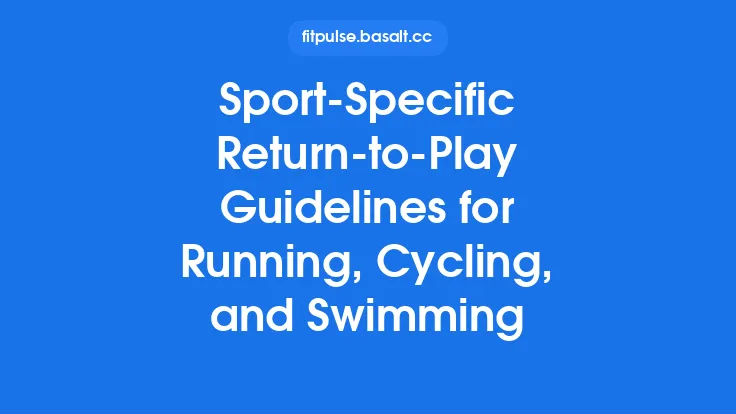Returning to training after an injury is a pivotal moment in an athlete’s rehabilitation journey. While the excitement of getting back on the field, track, or court is understandable, the decision to resume training must be grounded in a systematic assessment of multiple physiological and clinical factors. Rushing the process can jeopardize the healing tissue, increase the risk of re‑injury, and ultimately delay long‑term performance goals. This article outlines the core criteria that clinicians, coaches, and athletes should evaluate to determine whether the body is truly prepared to handle the stresses of training again. By focusing on objective, reproducible markers and a collaborative decision‑making framework, the return‑to‑training decision becomes both safe and evidence‑based.
Medical Clearance and Objective Clinical Indicators
A formal medical clearance remains the cornerstone of any return‑to‑training decision. This clearance should be based on a comprehensive clinical examination that confirms:
- Tissue Healing Status – Imaging (e.g., MRI, ultrasound) or clinical palpation should demonstrate that the injured structure has progressed through the expected phases of healing (inflammatory, proliferative, remodeling) and that any residual pathology (e.g., edema, scar tissue) is within acceptable limits.
- Absence of Acute Pathology – No signs of acute inflammation, infection, or new injury should be present. The clinician must verify that the original injury has not evolved into a chronic condition.
- Joint Integrity – For joint injuries, stability tests (e.g., Lachman for ACL, anterior drawer for ankle) should show no excessive laxity, and the joint capsule should be intact.
Only when these objective clinical markers are satisfied should the athlete be considered for the next tier of evaluation.
Pain and Symptom Resolution
Pain is a reliable barometer of tissue stress. The following thresholds are commonly used:
- Resting Pain – The athlete should report a pain level of ≤1 on a 0–10 numeric rating scale while at rest.
- Activity‑Induced Pain – During low‑intensity movements that mimic training motions, pain should not exceed 2–3/10 and must subside within 24 hours after activity.
- No Referred or Radiating Pain – Absence of pain that radiates beyond the primary injury site suggests that compensatory patterns are not being over‑taxed.
If pain persists beyond these limits, the underlying tissue may still be vulnerable, and further rehabilitation is warranted.
Range of Motion and Joint Stability
Adequate mobility and stability are prerequisites for safe training:
- Full, Pain‑Free Range of Motion (ROM) – The injured joint should achieve at least 90 % of the contralateral side’s ROM, measured with a goniometer or inclinometer.
- Dynamic Stability – Functional tests that assess the joint’s ability to maintain alignment under load (e.g., single‑leg squat, step‑down) should demonstrate controlled movement without excessive valgus or varus deviation.
Restoring ROM and stability reduces compensatory stresses on adjacent structures, which is essential for progressive training loads.
Strength and Power Benchmarks
Strength deficits are a primary predictor of re‑injury. The following criteria should be met:
- Symmetry Ratio – The injured limb should exhibit ≥90 % of the strength of the uninjured limb when measured with isokinetic dynamometry or handheld dynamometers.
- Power Output – For activities requiring explosive effort, the athlete should achieve at least 85 % of pre‑injury power metrics (e.g., vertical jump height, sprint acceleration) as recorded in baseline testing.
- Rate of Force Development (RFD) – RFD should be within 80–90 % of baseline values, indicating that the neuromuscular system can generate force quickly, a critical factor for most sports.
These quantitative thresholds provide an objective basis for determining whether the musculoskeletal system can tolerate training stresses.
Neuromuscular Control and Proprioception
Beyond raw strength, the ability to coordinate movement patterns is vital:
- Balance Accuracy – On a force platform or balance board, the athlete should maintain a center‑of‑pressure sway area ≤1.5 standard deviations of normative data for their sport and age group.
- Movement Quality – Video analysis of sport‑specific drills should reveal smooth, coordinated motor patterns without compensatory hip or trunk movements.
- Reactive Agility – The athlete should respond to unpredictable stimuli (e.g., light cues, partner movements) with reaction times comparable to pre‑injury baselines.
These neuromuscular markers ensure that the central nervous system has re‑integrated the injured limb into the athlete’s motor repertoire.
Cardiovascular and Metabolic Readiness
Even if the musculoskeletal system appears healed, the athlete’s overall conditioning must support training demands:
- Aerobic Capacity – VO₂max or submaximal endurance tests should be within 85 % of pre‑injury values, indicating sufficient cardiovascular reserve.
- Lactate Clearance – Post‑exercise blood lactate levels should return to baseline within 30 minutes, reflecting efficient metabolic recovery.
- Heart Rate Variability (HRV) – Resting HRV indices (e.g., RMSSD) should be within the athlete’s normal range, suggesting autonomic balance and readiness for higher training loads.
Adequate systemic conditioning helps prevent early fatigue, which can compromise technique and increase injury risk.
Integration of Sport‑Specific Demands
While the article avoids detailed sport‑specific protocols, it is essential to confirm that the athlete can perform the fundamental movement patterns intrinsic to their sport:
- Pattern Replication – The athlete should execute the core movement cycles (e.g., stride, swing, jump) at a speed and intensity that mirrors typical training sessions, without pain or loss of form.
- Load Tolerance – Using submaximal loads (≈60 % of anticipated training intensity), the athlete should complete the movement for at least 3–5 minutes without degradation in technique.
These criteria bridge the gap between generic clinical measures and the functional realities of sport.
Multidisciplinary Decision‑Making Process
A single perspective rarely captures the full picture. The final determination should involve:
- Medical Practitioner – Confirms tissue healing and clearance based on clinical findings.
- Physical Therapist/Strength Coach – Provides objective data on strength, ROM, and neuromuscular control.
- Athlete’s Self‑Report – Offers insight into perceived readiness, confidence, and any lingering discomfort.
- Performance Analyst (if available) – Supplies quantitative performance metrics for comparison with baseline data.
Consensus among these stakeholders ensures that the decision is balanced, reducing the likelihood of oversight.
Documentation and Ongoing Reassessment
Even after the athlete resumes training, continuous monitoring is essential:
- Training Log – Record load, volume, perceived exertion, and any pain or soreness after each session.
- Periodic Re‑Testing – At 1‑week and 2‑week intervals, repeat key strength, ROM, and neuromuscular assessments to verify that adaptations are progressing as expected.
- Threshold Alerts – Pre‑establish criteria (e.g., pain >3/10, strength drop >5 % from baseline) that trigger a temporary reduction in training intensity or a return to rehabilitation.
Documenting these parameters creates a feedback loop that safeguards the athlete’s long‑term health while allowing for incremental progression.
By systematically evaluating medical clearance, symptom resolution, mobility, strength, neuromuscular control, systemic conditioning, and sport‑specific movement fidelity, stakeholders can make an evidence‑based determination about an athlete’s readiness to return to training. This multidimensional approach not only minimizes the risk of re‑injury but also lays a solid foundation for sustainable performance improvements.





